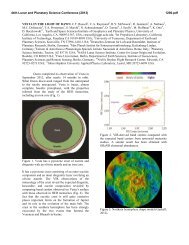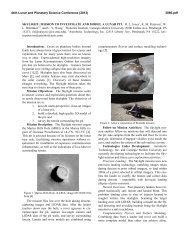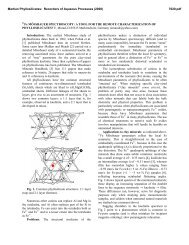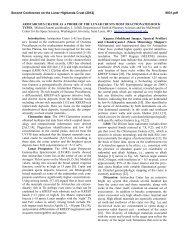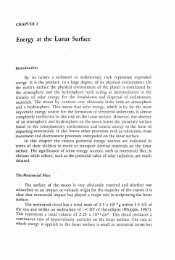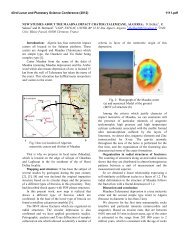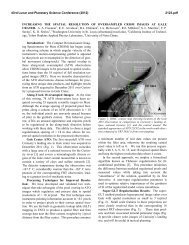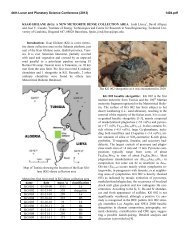Formation of Impact Craters - Lunar and Planetary Institute
Formation of Impact Craters - Lunar and Planetary Institute
Formation of Impact Craters - Lunar and Planetary Institute
Create successful ePaper yourself
Turn your PDF publications into a flip-book with our unique Google optimized e-Paper software.
24 Traces <strong>of</strong> Catastrophe<br />
Fig. 3.7. Simple impact structure: locations <strong>of</strong> impactite types. Schematic cross section <strong>of</strong> a typical simple impact structure, showing<br />
the simple bowl shape <strong>and</strong> the locations <strong>of</strong> various types <strong>of</strong> impactites in <strong>and</strong> around the structure. The parautochthonous rocks below<br />
the true crater floor are fractured <strong>and</strong> brecciated but generally show no distinctive shock effects, except in a small zone (fine vertical<br />
ruling) in the center <strong>of</strong> the structure. The crater is filled, to approximately half its original height, with a variety <strong>of</strong> allogenic breccias <strong>and</strong><br />
impact melts, which forms the crater-fill units or the breccia lens. A thinner layer <strong>of</strong> ejected material (fallout ejecta) overlies the uplifted<br />
crater rim <strong>and</strong> surrounds the crater. This unit is easily eroded <strong>and</strong> is present only in the youngest <strong>and</strong> best-preserved structures. D = final<br />
crater diameter, which is 10–20% greater than the diameter <strong>of</strong> the original, premodification transient crater; d t = true depth <strong>of</strong> the final<br />
crater, which is approximately the depth <strong>of</strong> the original transient crater; d a = apparent depth <strong>of</strong> the crater, or the depth from the final rim<br />
to the top <strong>of</strong> the crater-fill units. The diagram represents the state <strong>of</strong> the final crater before any subsequent geological effects, e.g., erosion,<br />
infilling. The model is based on drilling studies at Barringer Meteor Crater (Arizona) (Roddy et al., 1975; Roddy, 1978), Brent Crater<br />
(Canada) (Dence, 1968; Grieve <strong>and</strong> Cintala, 1981), <strong>and</strong> similar structures (e.g., Masaitis et al., 1980; Gurov <strong>and</strong> Gurova, 1991). (From<br />
Grieve, 1987, Fig. 1.)<br />
Depending on the subsequent geological history, the breccia<br />
lens may be eroded or may be covered <strong>and</strong> preserved by a<br />
cap <strong>of</strong> later sedimentary fill.<br />
3.2.2. Complex <strong>Craters</strong><br />
The bowl-shaped form <strong>of</strong> simple craters appears only in<br />
relatively small structures less than a few kilometers across.<br />
Larger impact structures (complex craters) display a different<br />
<strong>and</strong> more complicated form, characterized by a centrally<br />
uplifted region, a generally flat floor, <strong>and</strong> extensive inward<br />
collapse around the rim (Figs. 1.3, 3.8, <strong>and</strong> 3.9) (Dence, 1968;<br />
Grieve et al., 1977, 1981; Grieve, 1991). For terrestrial structures,<br />
the transition between simple <strong>and</strong> complex craters<br />
occurs at a diameter <strong>of</strong> about 4 km in massive crystalline<br />
rocks, but at only about 2 km in sediments. (However, these<br />
values apply only to Earth. The transition diameter varies<br />
inversely with gravitational acceleration, <strong>and</strong> it is different<br />
on different planets.) The larger impact events that form<br />
complex craters apparently release enough energy to overcome<br />
the fundamental strength <strong>of</strong> the target rocks over a<br />
large volume beneath the large transient crater. As a result,<br />
late-stage modification involves complex interactions between<br />
shock-wave effects, gravity, <strong>and</strong> the strength <strong>and</strong> structure<br />
<strong>of</strong> the target rocks, <strong>and</strong> the modification is characterized<br />
by outward, inward, <strong>and</strong> upward movements <strong>of</strong> large volumes<br />
<strong>of</strong> the subcrater rocks.<br />
The details <strong>of</strong> these interactions are uncertain, but the<br />
general result is that the original bowl-shaped transient crater<br />
is immediately modified as deep-seated rocks beneath<br />
the center <strong>of</strong> the transient crater rise to form a central uplift<br />
(Dence, 1968; Grieve et al., 1981). At the same time, rocks<br />
around the periphery <strong>of</strong> the transient crater collapse downward<br />
<strong>and</strong> inward along concentric faults to form one or more<br />
depressed rings (ring grabens) <strong>and</strong> a series <strong>of</strong> terraces along<br />
the outer margins <strong>of</strong> the final structure (Fig. 3.10). [A simple<br />
model <strong>of</strong> the formation <strong>of</strong> a complex crater <strong>and</strong> its central<br />
uplift is presented by the familiar slow-motion movies <strong>of</strong> a<br />
drop <strong>of</strong> liquid hitting a liquid surface (e.g., Melosh, 1989,<br />
p. 148; Taylor, 1992, p. 168). There is the same initial cavity<br />
formation, the same outward <strong>and</strong> downward ejection <strong>of</strong> target<br />
material, the same upward rebound <strong>of</strong> the central cavity<br />
floor, <strong>and</strong> the same collapse <strong>of</strong> the periphery back into the<br />
cavity. However, in impact events, these processes take place<br />
in solid rock <strong>and</strong> may operate over distances <strong>of</strong> tens to hundreds<br />
<strong>of</strong> kilometers.]<br />
The idea that such rapid deformation <strong>and</strong> subsequent<br />
uplift can occur in large volumes <strong>of</strong> crustal rocks has been<br />
difficult for many geologists to appreciate. Key evidence has<br />
come from studies <strong>of</strong> impact structures formed in sedimentary<br />
rocks, in which the actual uplift <strong>of</strong> key stratigraphic<br />
markers has been established beyond question through drilling<br />
<strong>and</strong> geophysical studies (e.g., Milton et al., 1972, 1996a,b;



